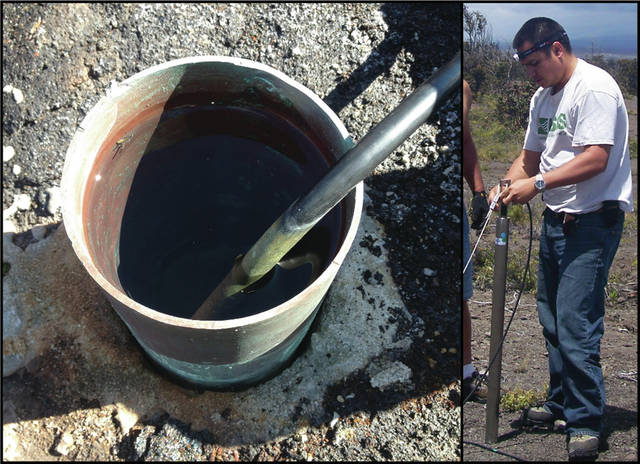VOLCANOES NATIONAL PARK — The USGS Hawaiian Volcano Observatory (HVO) uses a diverse set of instruments to monitor active volcanoes in Hawaii. These include seismometers, gas sensors, GPS stations, and webcams. Each provides a unique type of data critical to understanding volcanic systems.
However, electronic tiltmeters are the instruments that are often the first to alert us to changes in a volcano that could lead to an eruption. This is because they are exceptionally sensitive, capable of measuring very small ground deformations that suggest the movement of magma into shallow parts of volcanoes.
While tiltmeters respond to many subsurface processes, they are particularly effective for tracking inflation and deflation of subsurface magma reservoirs, like the shallow Halemaumau source at Kilauea’s summit. As magma moves into a subsurface reservoir, the reservoir expands to accommodate additional magma. This causes the ground above the reservoir to bulge, depending on how shallow it is.
As it bulges upward, the slope of the ground surface changes in certain places and in a specific pattern. This change in slope is what a tiltmeter measures, much like a carpenter’s level.
Tiltmeters commanded the spotlight at Kilauea during the events of May through August. Large changes in tilt just ahead of the collapse of Pu‘u O o on April 30 first heralded the major events about to happen. Tiltmeters and seismometers located along the volcano’s East Rift Zone (ERZ) were key for tracking magma intruding into the lower ERZ beneath Leilani Estates. At Kilauea’s summit, sudden changes in the direction of surface tilting were primary indicators that repeated collapse events, and not just earthquakes, had occurred.
The unit used when measuring tilt at a volcano is usually the microradian. This is an angular unit, just like “degrees.” A full circle is 360 degrees, equivalent to 6.28 radians. One microradian is, therefore, about 50 millionths of a degree — a very small change in ground slope. If you put a tiltmeter on a rigid plank that is one mile long, and then put a quarter under one end of the plank, the measured change would be about one microradian of tilt.
The tiltmeters that HVO use can resolve even smaller tilt changes — as small as 5 nanoradians. However, this great sensitivity comes at a cost. That’s because the tiltmeter records all changes in the ground tilt, whether they are due to changes in the volcano or another reason.
One non-volcanic source of tilt is the heating of the ground that happens on sunny days. Most of HVO’s tiltmeters are installed in boreholes about 10 to 13 feet below the ground and are surrounded by rock. This rock expands as it warms up during the day, and any unevenness in its expansion will produce an easily measurable ground tilt. This is “diurnal noise,” which can be easily identified because it happens regularly during the day.
Rainfall can also cause small amounts of tilt. Rock contains small air pockets, called pore spaces, which can become filled with water during a storm, causing the rock to swell up like a sponge. Small differences in pore spaces on either side of a tiltmeter will cause a measurable change in ground tilt. Remember, these are tilts that are much smaller than can be discerned by simply looking at a patch of ground with your eyes.
Another important source of noise at a tiltmeter is settling of the instrument in its borehole. This can last months, if not years, in some cases. It is a major contributor to tiltmeter “drift,” and, on a tilt record, can look like a long-term tilt change or trend.
Because of tiltmeter drift, we mainly trust tiltmeters for short time-scale changes. For changes over several months or years, we must look to other instruments, such as GPS, for deformation data. It also means that the usefulness of a tilt record is how the tilt changes within a week or a month, and not necessarily the absolute value of tilt produced by the instrument.
Despite these effects, electronic tiltmeters offer one of our best views into subsurface changes at Kilauea and Mauna Loa volcanoes, and are an important part of our monitoring toolbox.
Volcano Activity Updates
At Kilauea’s lower East Rift Zone (LERZ), the most recent significant incandescence visible within the fissure 8 cone was on Sept. 15. At the summit of the volcano, seismicity and ground deformation remain low. Hazardous conditions still exist at both the LERZ and summit. Residents in the lower Puna District and Kilauea summit areas on the Island of Hawaii should stay informed and heed Hawaii County Civil Defense closures, warnings, and messages (https://www.hawaiicounty.gov/active-alerts).
No collapses at Pu‘u O o have been observed during the past two weeks.
The combined sulfur dioxide emission rates at Kilauea’s summit, Pu‘u O o, and lower East Rift Zone remain at less than 1,000 tonnes per day — lower than at any time since late 2007.
The USGS Volcano Alert level for Mauna Loa remains at normal.
HVO continues to closely monitor both Kilauea and Mauna Loa and will report any significant changes on either volcano. Daily Kilauea updates are posted at https://volcanoes.usgs.gov/volcanoes/kilauea/status.html. Monthly Mauna Loa updates are posted at https://volcanoes.usgs.gov/volcanoes/mauna_loa/status.html.
Two earthquakes with three or more felt reports occurred in the Hawaiian Islands this past week: a magnitude-3.2 quake 9 miles north-northwest of Waikoloa Village at 20 miles depth on Sept. 26 at 5:42 p.m. HST; and a magnitude-3.7 quake 11 miles southeast of Volcano at 4 miles depth on Sept. 21 at 1:56 a.m. HST. Small aftershocks from the May 4, magnitude-6.9 earthquake are still being generated on faults located on Kilauea’s south flank.
Please visit HVO’s website or past Volcano Watch articles, Kilauea and Mauna updates, volcano photos, maps, recent earthquake info, and more. Call 967-8862 for a Kilauea summary update. Email questions to askHVO@usgs.gov.
Volcano Watch is a weekly article and activity update written by U.S. Geological Survey Hawaiian Volcano Observatory scientists and affiliates. This week’s article was written by HVO geophysicist Ingrid Johanson.






